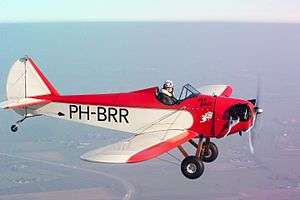Bowers Fly Baby
The Bowers Fly Baby is a homebuilt, single-seat, open-cockpit, wood and fabric low-wing monoplane that was designed by famed United States aircraft designer and Boeing historian, Peter M. Bowers.
| Bowers Fly Baby | |
|---|---|
 | |
| Role | Sport and personal aircraft |
| Manufacturer | homebuilt aircraft |
| Designer | Peter M. Bowers |
| First flight | 1962 |
| Produced | 1962-today |
| Number built | more than 500 |
| Unit cost |
US$10,000 (2007) |
| Variants | Duane's Hangar Ultrababy |
.jpg)
Development
The prototype Fly Baby first flew in 1962. It is now on display at the Museum of Flight in Seattle.
Variants include a biplane version called the Bowers Bi-Baby or Fly Baby 1-B and several dual cockpit designs by various builders. Bowers also designed a side-by-side two-seat version he called Namu, but few examples have been built.[1]
The Fly Baby was the winner of the Experimental Aircraft Association's 1962 design competition.[1]
Over 500 Fly Babies have been completed to date, with scores still flying worldwide and an active network of builders and owners. It is built from plans and was designed to be constructed in a garage using only basic hand tools, by a person of average "home handyman" skill in 1962. The plans consist of over one hundred pages of typewritten instructions and dimensioned drawings. After Bowers' death in 2003 the plans were unavailable for a time, but starting in 2007 they were back on the market, sold by the Bowers family.[2][3][4]
Design
The Fly Baby was designed to be a very simple aircraft. For example, the fuel gauge is a stiff wire attached to a float poking up through the gas cap (a common application in the 1930s and 1940s, as seen on Piper and Aeronca light aircraft). The structure is of aircraft-grade spruce and plywood (Bowers did not advocate skimping on the quality of structural wood), covered with doped aircraft fabric. Aileron controls are push-tube, elevator controls are a combination of push-tube and cable, the rudder is cable-controlled.[1]
The landing gear is fixed and unsprung. The main landing gear struts are made of laminated wood with a steel axle. The only shock absorption comes from the tires themselves. Hydraulic wheel brakes are usually fitted.
The aircraft was designed to be powered by a 65-horsepower (48 kW) Continental A-65 piston engine taken from a Piper Cub. Engines of up to 100 horsepower (75 kW) have been fitted, including the Continental O-200 and converted Corvair automotive conversions.[5]
While the instrumentation installed is up to the builder, most Fly Babys are equipped for visual flight rules (VFR) only. An electrical system is optional; many Fly Baby owners hand-prop the engine for starting, and use a handheld radio.
The Fly Baby's wings fold up against the fuselage enabling it to be stored in a single-car garage or a car trailer. The wings can be folded or unfolded in about 15 minutes. The airplane was designed to be stored in a garage and towed to the airport on its own gear. In practice, most owners use a trailer or keep their Fly Baby hangared at an airport.
Some of the components used, such as the fuel tank and engine, were designed to be taken from the Piper Cub, which were cheap and plentiful in 1962. Even today, the total cost of construction can be under US$10,000.
Variants
Regulations
USA
In the United States of America the FAA categorizes the Fly Baby as an Experimental Amateur-Built aircraft. It also fits the FAA's specifications for a Light Sport Aircraft and can be flown in the US by pilots holding a Recreational Pilot or Sport Pilot certificate.
Canada
In Canada the Fly Baby may be built as an amateur-built aircraft[7] or as a basic ultra-light aeroplane.[8] It may be flown with an Ultra-light Pilot Permit or higher aeroplane licence.[9]
Specifications (Fly Baby)
Data from Plane and Pilot: 1978 Aircraft Directory[1]
General characteristics
- Crew: one pilot
- Length: 18 ft 10 in (5.74 m)
- Wingspan: 28 ft 0 in (8.54 m)
- Wing area: 120 sq ft (12.24 m2)
- Empty weight: 605 lb (274 kg)
- Max takeoff weight: 924 lb (419 kg)
- Powerplant: 1 × Continental C-85 flat-four engine, 85 hp (63.9 kW)
Performance
- Maximum speed: 120 mph (194 km/h, 100 kn)
- Cruise speed: 110 mph (178 km/h, 96 kn)
- Stall speed: 45 mph (73 km/h, 39 kn)
- Range: 300 mi (486 km, 260 nmi) at 8,000 ft (2,438 m)
- Rate of climb: 1,100 ft/min (5.6 m/s)
- Wing loading: 7.7 lb/sq ft (34.2 kg/m2)
- Power/mass: 10.8 lb/hp (6.56 kg/kW)
See also
Comparable aircraft
- Ameri-Cana Eureka
- Murphy JDM-8
- Hanson Woodwind, Scott Ol' Ironsides - Construction methods based on Bower's Fly Baby plans.[10]
References
- Plane and Pilot: 1978 Aircraft Directory, pages 135-136. Werner & Werner Corp, Santa Monica CA, 1977. ISBN 0-918312-00-0
- Wanttaja, Ron (July 2008). "The Unofficial Fly Baby Home Page". Retrieved 2008-10-13.
- Bayerl, Robby; Martin Berkemeier; et al: World Directory of Leisure Aviation 2011-12, page 97. WDLA UK, Lancaster UK, 2011. ISSN 1368-485X
- Tacke, Willi; Marino Boric; et al: World Directory of Light Aviation 2015-16, page 103. Flying Pages Europe SARL, 2015. ISSN 1368-485X
- "Corvair powered Flybaby, Goode and Brantley, Georgia". flycorvair.net. 25 November 2013. Retrieved 4 April 2018.
- Air Trails: 79. Winter 1971. Missing or empty
|title=(help) - Transport Canada (2005-02-02). "EXEMPTION FROM SECTION 549.01 OF THE CANADIAN AVIATION REGULATIONS AND CHAPTER 549 of THE AIRWORTHINESS MANUAL – AIRWORTHINESS STANDARDS - AMATEUR-BUILT AIRCRAFT". Archived from the original on 2008-03-12. Retrieved 2007-10-17.
- Transport Canada (2007-04-17). "Ultra-light Aeroplane Transition Strategy". Archived from the original on 2008-03-12. Retrieved 2007-10-17.
- Transport Canada (2005-12-01). "CAR 401.21 Ultra-light Aeroplanes - Privileges". Archived from the original on 2009-01-20. Retrieved 2007-10-17.
- Sport Aviation. August 1970. Missing or empty
|title=(help)
External links
| Wikimedia Commons has media related to Bowers Fly Baby. |